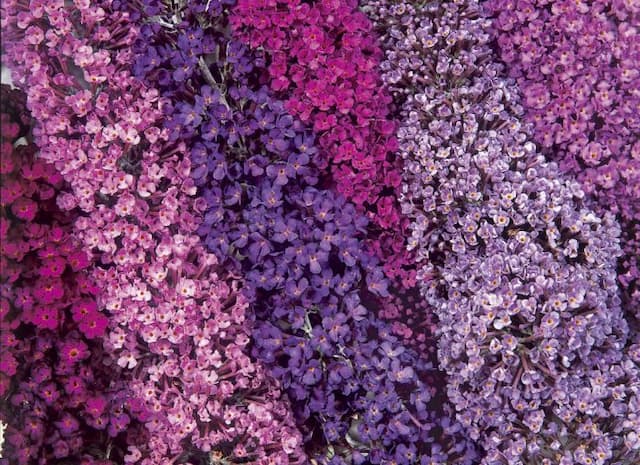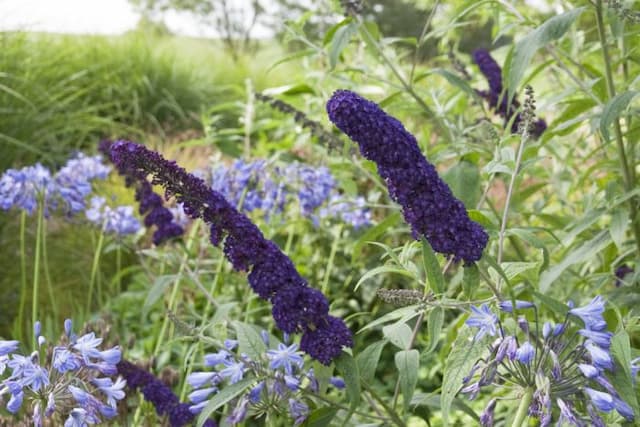Pale butterfly bush Buddleja officinalis

ABOUT
B. officinalis is a medium to large, semi-evergreen shrub with pale mauve, yellow-eyed, strongly fragrant flowers through winter into early spring. Leaves are dark green and strongly felted grey-white beneath with some sparser hairs on the upper surface too at times
About this plant
 Names
NamesFamily
Scrophulariaceae
Synonyms
Butterfly Bush, Mi Menghua
Common names
Buddleia officinalis, Chilianthus retusus, Buddleja asiatica var. albiflora, Buddleja macrostachya.
 Characteristics
CharacteristicsLife cycle
Perennials
Foliage type
Deciduous
Color of leaves
Green
Flower color
Purple
Height
6 feet (1.8 meters)
Spread
5 feet (1.5 meters)
Plant type
Shrub
Hardiness zones
5
Native area
China
Benefits
 General Benefits
General Benefits- Attracts Pollinators: Butterfly Bush is known for attracting butterflies, bees, and other beneficial insects to the garden.
- Aesthetic Appeal: This plant adds visual interest to gardens with its vibrant flowers that come in a variety of colors such as pink, purple, and white.
- Ease of Care: Butterfly Bush is generally low-maintenance, drought-tolerant once established, and can thrive in a range of soil types.
- Fast Growth: Butterfly Bush can grow quickly, filling in garden spaces and providing a lush look in a relatively short time.
- Privacy Screening: With its size and density of foliage, Butterfly Bush can be used to create natural privacy screens in landscaping.
- Erosion Control: The robust root system of Butterfly Bush can help stabilize soil and prevent erosion on slopes and banks.
- Habitat Restoration: It is sometimes used in habitat restoration projects to provide food and shelter for wildlife.
 Medical Properties
Medical Properties- Anti-inflammatory: Buddleja officinalis extracts have been studied for their potential anti-inflammatory effects.
- Antioxidant: The plant contains compounds with antioxidant properties, which might help in protecting cells from oxidative stress.
- Hepatoprotective: There is some evidence to suggest that Buddleja officinalis could offer liver-protecting benefits.
- Antibacterial: Components of the plant have shown antibacterial activity in some studies, suggesting it could help in treating bacterial infections.
- Ocular health: Traditionally, Buddleja officinalis has been used for eye-related conditions, such as improving vision and treating eye inflammation.
- Antitumor: There is preliminary research indicating that the plant might have antitumor properties, though this is not confirmed for clinical use.
 Air-purifying Qualities
Air-purifying QualitiesThis plant is not specifically known for air purifying qualities.
 Other Uses
Other Uses- Butterfly Attraction: Butterfly bush (Buddleja officinalis) is popular in gardens designed to attract butterflies due to its nectar-rich flowers.
- Bee Forage: The plant also serves as an excellent source of forage for bees, contributing to the health of local bee populations.
- Eco-Friendly Dye: The flowers of the butterfly bush can be used to create a natural and eco-friendly dye for fabrics and crafts.
- Livestock Fodder: In some regions, the foliage of Buddleja officinalis may be used as fodder for livestock due to its nutritional content.
- Horticultural Research: The growth patterns and hardiness of the butterfly bush make it a subject of interest in horticultural and botanical research.
- Windbreaks: Due to its rapid growth and dense foliage, butterfly bush can be planted to create natural windbreaks in gardens and agricultural fields.
- Erosion Control: The robust root system of the butterfly bush helps stabilize soil and can be used in efforts to control erosion.
- Garden Aesthetics: With its vivid blossoms and long blooming period, Buddleja officinalis is planted for aesthetic enhancement in landscape design.
- Privacy Screening: Butterfly bush can grow into thick, tall hedges that are used to create natural privacy screens in residential areas.
- Ornamental Crafts: Dried flower spikes from Buddleja officinalis may be used in ornamental crafts, such as wreaths and dried flower arrangements.
Interesting Facts
 Feng Shui
Feng ShuiThe Butterfly Bush is not used in Feng Shui practice.
 Zodiac Sign Compitability
Zodiac Sign CompitabilityThe Butterfly Bush is not used in astrology practice.
 Plant Symbolism
Plant Symbolism- Healing: Buddleja officinalis, commonly known as the Butterfly Bush, is often associated with healing due to its medicinal properties.
- Attraction: This plant is known to attract butterflies, making it a symbol for allure and the ability to attract good things.
- Rebirth: The Butterfly Bush's ability to attract butterflies—creatures that symbolize transformation—associates the plant with rebirth and new beginnings.
- Immortality: In some traditional medicines, the Butterfly Bush is believed to possess qualities that promote longevity, thereby symbolizing immortality.
 Water
WaterButterfly bush should be watered deeply but infrequently, to encourage deep root growth. Water the plant once a week with about 1 to 1.5 gallons of water, adjusting for rainfall, as the plant prefers to dry out slightly between waterings. During the heat of summer, you may need to water more frequently, especially if your butterfly bush is in a container. Reduce watering in the winter when the plant is dormant. Overwatering can lead to root rot, so ensure the soil has good drainage.
 Light
LightButterfly bush thrives best in full sun, meaning it should receive at least 6 to 8 hours of direct sunlight daily. The ideal spot for this plant is in a bright, south-facing location where it receives ample sunlight throughout the day. However, it can tolerate some light shade, particularly in regions with very hot summers.
 Temperature
TemperatureButterfly bush prefers a temperate climate and does well in a temperature range of 60 to 90 degrees Fahrenheit. It is hardy in USDA zones 5 through 9, which means it can withstand winter low temperatures down to -20 degrees Fahrenheit. To promote vigorous growth, keep the butterfly bush in an area where the temperature is within its preferred range.
 Pruning
PruningPruning is important for butterfly bush to maintain its shape, encourage new growth, and promote more blooms. It should be pruned in late winter or early spring, cutting back the previous year's growth to about a foot from the ground. This plant blooms on new wood, so annual pruning can also result in larger flower spikes.
 Cleaning
CleaningAs needed
 Soil
SoilButterfly Bush (Buddleja officinalis) thrives in well-draining soil with plenty of organic matter. A soil mixture containing garden soil, peat moss, and perlite or course sand in equal parts is ideal. The preferable soil pH for Butterfly Bush is between 6.0 and 7.0, slightly acidic to neutral.
 Repotting
RepottingButterfly Bush (Buddleja officinalis) should be repotted every two to three years to ensure healthy growth and to refresh the soil. Younger plants may need repotting more frequently, especially if they are growing rapidly and become root-bound.
 Humidity & Misting
Humidity & MistingButterfly Bush (Buddleja officinalis) is adaptable to a range of humidity levels but prefers moderate humidity. It does not have specific humidity requirements, making it suitable for average home or garden conditions.
 Suitable locations
Suitable locationsIndoor
Place in bright, indirect light and ensure good airflow.
Outdoor
Plant in sun to partial shade in well-drained soil.
Hardiness zone
5-9 USDA
 Life cycle
Life cycleBuddleja officinalis, commonly known as the butterfly bush, begins its life cycle with seed germination, typically occurring in warm, well-drained soil conditions. Seedlings emerge and establish a root system before developing into young plants with characteristic lance-shaped leaves. As the plants mature, they develop woody stems and branches, becoming shrubs that can reach several meters in height. During late winter to early spring, Buddleja officinalis enters its flowering stage, producing fragrant purple or pink flowers that attract butterflies and other pollinators. After pollination, the flowers develop into small capsules containing seeds, which disperse to propagate the next generation of plants. Finally, in temperate regions, the plant may undergo a period of dormancy during the cold months, shedding leaves and conserving energy until the next growing season.
 Propogation
PropogationPropogation time
Spring
Propogation: Buddleja officinalis, commonly known as Butterfly Bush, is best propagated by semi-hardwood cuttings. Usually, the best time to take these cuttings is in late summer after the bloom period, when new growth has partially matured. To propagate, one should select a healthy, disease-free branch and cut a piece that is 4 to 6 inches long, with several sets of leaves. Remove the leaves from the lower half of the cutting to expose the nodes. The bottom cut should be made just below a node, as this is where roots tend to form more easily. The cuttings should then be dipped in a rooting hormone powder to increase the chances of successful root development and planted in a well-draining soil mix. After planting, it’s crucial to maintain high humidity around the cuttings, which can be achieved by covering them with a plastic dome or bag, and keeping them in indirect light until roots have established.


![Butterfly bush [Adonis Blue]](/_next/image?url=https%3A%2F%2Fplants-admin.emdemapps.com%2Fimages%2Fplants%2F%2Fimages%2F604b56e58f983.png&w=640&q=75)


![Butterfly bush [Buzz Ivory]](/_next/image?url=https%3A%2F%2Fplants-admin.emdemapps.com%2Fimages%2Fplants%2F%2Fimages%2F604b57987dfa8.png&w=640&q=75)
![Butterfly bush [Camberwell Beauty]](/_next/image?url=https%3A%2F%2Fplants-admin.emdemapps.com%2Fimages%2Fplants%2F%2Fimages%2F604b5ead04c12.png&w=640&q=75)


